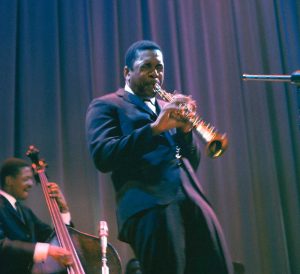By April 1964, John Coltrane’s fabled quartet was into its third straight year of regular touring. Buoyed by the success of “My Favorite Things”, they were playing concerts 45 weeks a year, six nights a week, and the bond between Coltrane, McCoy Tyner, Jimmy Garrison and Elvin Jones was getting stronger and stronger. The quartet was also attracting an ever-larger audience of college students in Europe and America.
But it had been an eventful period in Coltrane’s private life too. He had separated from his wife Naima and set up home with the young pianist Alice McLeod, with whom John was expecting his first child. And though the “Ballads” album and his collaborations with Johnny Hartman and Duke Ellington had been very successful, he was yearning to record longer, more searching pieces, even as “The Sidewinder” and Stan Getz/João Gilberto collaborations were storming the pop charts.
A new contract was inked with Impulse!, and on 27 April 1964, Coltrane entered Rudy Van Gelder’s studio to record his first all-new material in almost three years, apart from the 6 March 1963 session that had spawned the music on the posthumous release “Both Directions At Once”.

John Coltrane Both Directions At Once
Available to purchase from our US store.What emerged was quite unlike anything else he’d recorded and one of the most underrated gems in his catalogue. Wistful, introspective, melancholic but intense, and strongly foregrounding his three collaborators, “Crescent” was also obviously a sketchbook for the impending “A Love Supreme”, though arguably better-recorded, warmer and more welcoming. Coltrane also revealed that at least three tracks – “Wise One”, “Lonnie’s Lament” and “The Drum Thing” – were inspired by poems that he would often leave around the house for Alice to read.
The title track introduces us to a new soundworld, at once hymnal and Africa-tinged, before a much-copied B section (check out Stanley Clarke’s “Tradition”) and fascinating 4/4 swing interlude with Jones’s vocal exultations much in evidence. Coltrane’s recent explorations into standard tunes yield bold, new colours here – no longer “out” or “angry”, just perfectly integrated. His “Crescent” solo (during most of which Tyner is absent) was recently chosen by Dave Liebman as one of jazz’s 40 essential solos in the October 2017 issue of JazzTimes. (Liebman also named “Crescent” as his favourite Coltrane album ahead of “A Love Supreme”, as did legendary jazz executive Michael Cuscuna.)

The melancholic, prayer-like “Wise One” develops into a workout for one of Jones’s patented Latin-influenced mid-tempo grooves (except for a fascinating moment at 7:06 when he almost pulls Garrison into a swing feel), while “Lonnie’s Lament” is simply one of the prettiest themes in the entire Coltrane catalogue, with its Japanese flavours and rare unaccompanied Garrison solo.
In comparison, “Bessie’s Blues” is almost a throwaway, a short, joyful celebration of Coltrane’s newfound lyricism, while “The Drum Thing” is essentially a vehicle for Jones’s trademark tom-tom/kick-drum figures, alongside a lovely opening/closing theme again suggesting Spain or North Africa.
Most of “Crescent” was recorded on 27 April 1964, but the quartet returned to Van Gelder’s studio on 1 June to re-record “Bessie’s Blues” and the title track. Three weeks later, they taped the “Blue World” soundtrack album. Then, on 29 June, Coltrane’s treasured friend and collaborator Eric Dolphy died at the age of just 36. All told, 1964 had proved to be a pivotal, highly eventful year for John Coltrane, offering much food for thought and culminating in the December recording of “A Love Supreme”.

JOHN COLTRANE Crescent
Available to purchase from our US store.Want more John Coltrane records? Check out the whole collection on the Everything Jazz store.
Matt Phillips is a London-based writer and musician whose work has appeared in Jazzwise, Classic Pop, Record Collector and The Oldie. He’s the author of “John McLaughlin: From Miles & Mahavishnu To The 4th Dimension”.
Header image: John Coltrane. Photo: Gai Terrell/Redferns via Getty.



